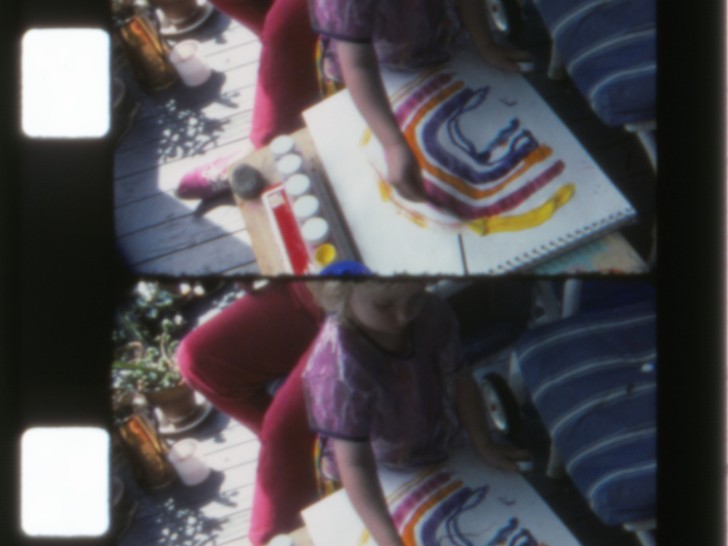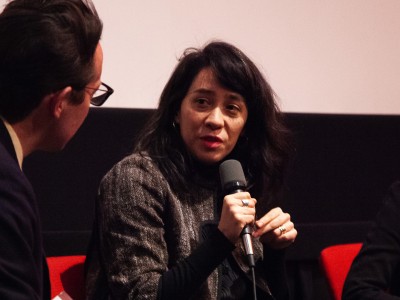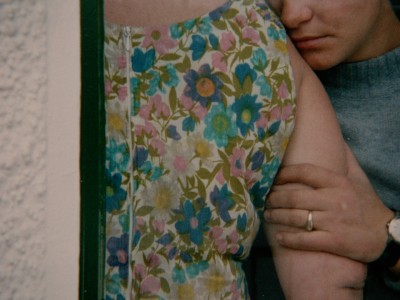
I Wanted to See How I Lived, I Wanted to Love Myself and My Past. A Tribute to Anne Charlotte Robertson, Program Two with introduction by Liz Coffey and Saul Levine.
Transcript
Liz Coffey 0:00
[INITIAL AUDIO MISSING] –film conservator here. And I'm glad that you've come to tonight's screening of Anne Robertson's films. Anne Robertson was a Super 8 filmmaker from Framingham, Massachusetts. She got her BA in Art and Psychology from UMass Boston and her Masters of Fine Arts and Filmmaking from MassArt. She lived in Mission Hill and Jamaica Plain and then she moved back to Framingham after she was done with Boston. Her work came to the Harvard Film Archive after she passed away last year from cancer. We have her films, we have hours and hours of audio tape, diaries, paperwork, paper diaries, little things that went with her films—like if you looked at the display case on the way in, there's some cardboard signs that she made to have shown at her screenings. A lot of different items that came in. There's also a huge amount of Super 8 films that were never edited into anything longer. There's boxes and boxes of camera rolls. It's a pretty huge collection. Her work is very personal. Her Five Year Diary spanned 1981 to 1997, and it's about forty hours long. And the diary continued into both the paper and audio tape recordings.
The diary films started out in 1981 on silent film. Her goal was to document her weight, and try to keep her weight from fluctuating. Thinking that she would be able to lose weight by making this film, she ended up gaining weight, and then she decided the film was about more than just what she weighed. And she brought in a lot of different topics from her life. She started experimenting with having audio cassettes that were the soundtrack to the film, so sometimes it'd be a silent reel of film with an audio tape that would go with it. Later she moved to Super 8 sound. And how that works, if you don't know, is Super 8 would have two stripes of magnetic oxide that would be the place where you can record sound. If you had a Super 8 sound camera, you can record on one stripe, and you can record on the other stripe in the projector when you're playing it back. So you could potentially have two channels of sound. She would add to that the audio tapes and then also a live narration. I've heard she also played the radio. So it was kind of a cacophonous performance of sound and picture.
Saul Levine was her professor at MassArt. He has been teaching there since 1978. And he will be speaking in a few minutes. I'm hoping he will try to describe her performance of the Diary as her thesis show. I've seen some paperwork that went with it. If you picked up this brown flyer at the door, this is from some of what we showed last night, and she had this kind of like seven or eight page description of her work that was a pretty great. There is also some more reproductions from that in the display case that our publicist Brittany Gravely put together.
In 1980, he presented the entire diary at the Museum of the Moving Image in New York as a gallery installation. And I found this piece of this document in her papers which I think is connected to this. The title at the top is “Environment/Installation.” And this first heading is “Survivalism/Bomb Shelter.” “Plastic water jugs filled, cot, sleeping bag, pillows, quilts, camp stove and fuel, lantern and fuel, large plastic garbage cans, small can with lid, toilet paper, disinfectant, extra blankets and pillows for audience, Army surplus waterproof ammunition boxes in case it's a flood instead, seeds, plant books soil testing kit, gardening tools, barbells and rowing machine, paper radiation suits and plastic goggles, gloves, first-aid kit and books, food chest with dried and canned goods, books on wild food, bicycle, skis, washtub, soap, towels, scrub board, folding chairs, tool chest, hatchet.” This is about this much of this piece of paper. This list goes on of all the things that she would have for this proposed installation. I imagine that her installation at the Museum of the Moving Image had something that was sort of connected to this. If anyone here has been there, I would love to know more about it.
The films we’ll be showing tonight span three decades. They were all originally Super 8 and are presented tonight on DigiBeta. New transfers were made by Brodsky and Treadway, which is an award-winning Super 8 film lab in Rowley, Massachusetts. They worked with Anne during her lifetime, and are very connected to her work. There's some technical issues around Super 8 sound that make film-to-film preservation really challenging in this day and age, which is basically that Super 8 sound was eighteen frames a second and sound film that is made today is 16 or 35, and it's always twenty-four frames a second, and this causes a disconnect in the film preservation process that makes it very complicated. So right now, it's really great that we can work with a digital format. Although we'd prefer to be working with film. We can no longer make Super 8 prints, which is a problem. But the work that's been done—I think you'll agree—looks really fantastic, so we're really pleased to be able to show it tonight.
Subways is the first short you'll see. It was made in 1976, which is the year that Anne started making films. The sound was recorded separately on an audio cassette and would have originally been played with the projection, but they've been married for the transfer. Going to Work is from 1981 with sound on film, My Cat, My Garden and 9/11 is Anne’s last completed Super 8 film from 2001. And the two Five Year Diary reels are from the mid 90s. And the recording that you'll hear coming out of the left speakers is—I think I've got the sides right—but I think the left is the original recording that was made on the sound stripe on the film. The recording on the right is a recording she made at Brodsky and Treadway, which is an attempt to redo the narration that she would have done live. She wanted to be able to distribute these films more widely than they would be seen if she was traveling with them. So she figured out that she could record her live narration and have it separated so we can kind of tell which is which without them getting just too squished together. Okay, that's all I have to say to you. But I will now introduce Saul Levine, who was her professor at MassArt. He's been a professor there since 1978. As you probably know, he's also a Super 8 filmmaker and is responsible for an important weekly film show, Film Society. I'm sure he's not a stranger to you. Thank you, Saul.
[APPLAUSE]
Saul Levine 7:39
Thank you, Liz. I’d like to thank the Harvard Archive and Liz, especially, for undertaking the preservation of Anne’s work. And Bob Brodsky and Toni Treadway, who were major supporters way beyond what you could believe. I know other archivists or preservationists like Bill Brand have done amazing things. But Bob, and especially Toni, supported Anne in so many ways in helping nurture and care for her and really are responsible for our being able to see this work. And I have to say, I was very skeptical that that Anne’s diary could be presented in a way that would be some kind of facsimile of the actual experience of having her there. But last night, I thought that they made great choices putting it on DigiBeta. I think it's a great projection format that preserves a lot of the quality of the film in terms of color and sound. Although what's missing is all the chaos and static of Super 8 projection. When I saw this work outside in Somerville in a garden, which was amazingly appropriate because Anne was so involved in gardening. And being bitten by mosquitoes while watching her film. And also there's always this kind of sadness, especially seeing work by people like Anne Robertson or Jack Smith, because there is always an element missing. They are people who were so much about performance, that the performative element is always gone, but I think this presentation, using the cassettes—thankfully that Anne recorded—really gives you some some measure of it, but you're not getting her physical presence. If she were here now, you probably wouldn't know who she was in the audience. She'd be just sitting there coming in from the back. And then in the middle of the film, somebody would start talking and you'd look and you'd see this person and then you'd be saying, “Well, it seems to go with it. But is she somebody that some disturbed person who just wandered in?” The same thing would happen with Jack Smith? “Or is she really the filmmaker?” And then you would get it because you would hear how wonderful these things fit in but there'd be that moment of panic of What's going on?! Normally when we go to the movies, or especially here, if you open up a bag of potato chips David or Haden is like, or somebody from the audience is sure to tell you “This is entirely inappropriate,” and for somebody to get up and make noise and start reading from a diary? This is unacceptable at a film program.
I'm wanting to speak not so much as from MassArt; I want to really just speak as her friend and colleague ‘cause Anne belonged to a unique club, Super 8 filmmakers in Boston. And during the late 70s, 80s and 90s, Boston was really a very hot place for Super 8 filmmaking, partly because of Bob and Toni, partly because Super 8 Film, the company, was here. Leacock. There was a lot of excitement about Super 8 as a media. And it was shared by not only people from the avant-garde but people like Ricky Leacock or Bob Doyle, Brodsky and Toni Treadway, who were interested in a more democratic, approachable media. A media that anyone could approach and find moving Image work as an art and Anne fell into this.
I was putting out a magazine at that time called Extreme and I wanted to do an issue on Anne Robertson and Joe Gibbons, because they were both doing cutting edge work with Super 8 film and live performance and humor. Each one of them were exponents of a very kind of dark comedy that shed light with laughter on some of the more perplexing, deep problems of the age. It's interesting to me that Anne's work—which had so much involved—was such an outpouring of confronting the daily issues of a woman in America in the late 20th century that her work was championed by all of the bad old men of avant-garde film—Stan Brakhage and Jonas Mekas—and not so much by the feminist critics. Anne was great at getting her work out. She had a lot to teach me about that. Anne who suffered from poverty, bad health, all kinds of stuff, really became an international filmmaker. She pulled herself up, she made that happen. That wasn't because of me, that wasn't because feminist, for example, film scholars said, “Oh, here's a woman struggling with body image problems, with weight loss or whatever.” Anne really wrote grants, sent her films around to festivals, was always there to go places and drove me around a lot to New York, ‘cause I had abandoned my car. We went to all the new masters of Super 8. She took Luther and I and Joe down there. She was a great companion. She drove me to Marjorie Keller's funeral service in Yorktown, Pennsylvania. I'll always treasure those trips. And also her coming over to my house, our smoking pot together and looking at films and talking about the problems of being a Super 8 filmmaker in Boston. So I've now talked entirely too much. You're about to hear much more interesting words from Anne. I hope that this show is the beginning of people who are excited about film, coming to terms with this great body of work, that this is a beginning and not an ending. Anne left us with a great body of work and it's now our job to appreciate it.
[APPLAUSE]
©Harvard Film Archive
Related film series

I Wanted to See How I Lived, I Wanted to Love Myself and My Past.
A Tribute to Anne Charlotte Robertson
Explore more conversations
Nathaniel Dorsky & Charles Hallisey

Laura Huertas Millán

Masha Matzke & Sarah Keller

